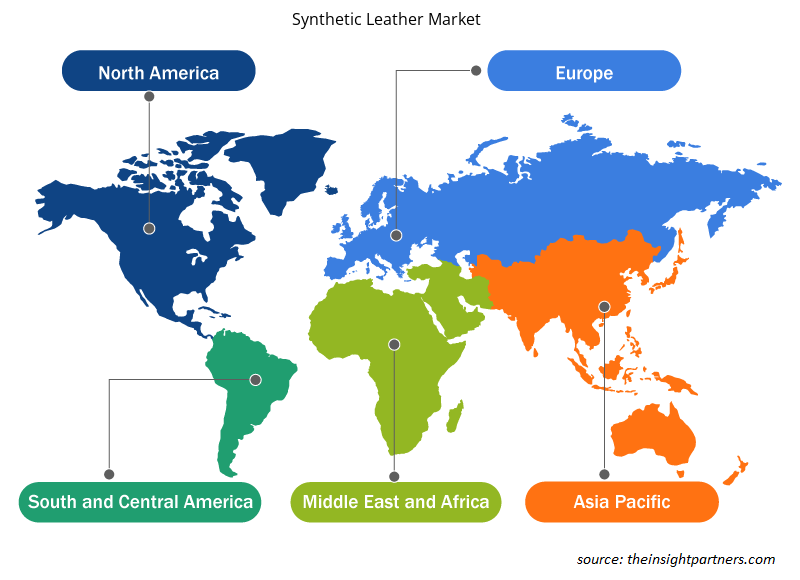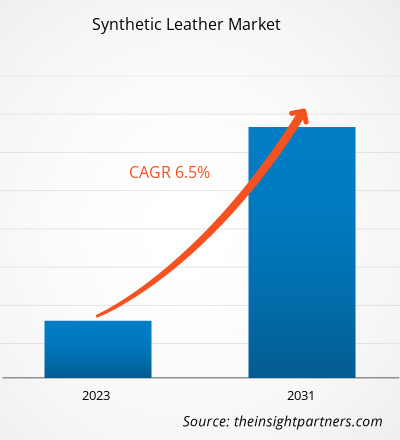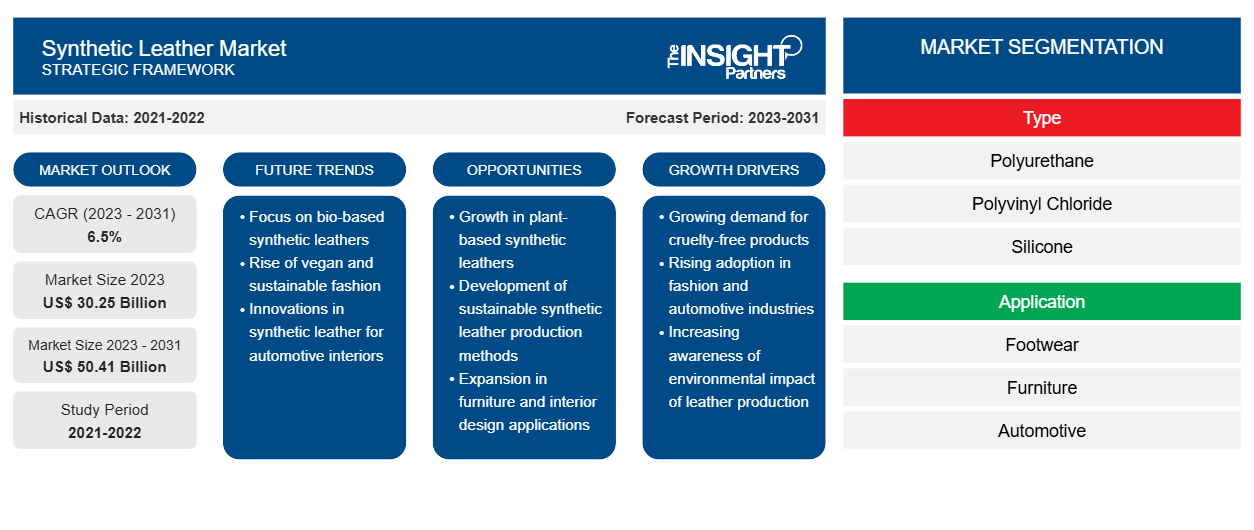Der Markt für Kunstleder soll von 30,25 Milliarden US-Dollar im Jahr 2023 auf 50,41 Milliarden US-Dollar im Jahr 2031 anwachsen. Der Markt wird voraussichtlich zwischen 2023 und 2031 eine durchschnittliche jährliche Wachstumsrate von 6,5 % verzeichnen. Der wachsende Fokus auf die Entwicklung von biobasiertem Leder dürfte ein wichtiger Trend auf dem Markt für Kunstleder bleiben.
Analyse des Kunstledermarktes
Kunstleder hat in den letzten Jahren an Popularität gewonnen. Es wird in verschiedenen Branchen verwendet, darunter in der Schuh-, Bekleidungs-, Möbel- und Automobilindustrie. Kunstleder wird am häufigsten für Kleidung, Gepäck und Koffer verwendet. Kunstleder wird zunehmend für Jacken, Mäntel, Handtaschen, Geldbörsen, Gürtel usw. verwendet. Kunstleder eignet sich aufgrund seiner geringen Kosten und Abriebfestigkeit für die Schuhherstellung.
Marktübersicht für Kunstleder
Kunstleder wird durch Extrusion von Rohstoffen wie Polyvinylchlorid, Polyurethan, Farbpigmenten, Trägermaterialien und anderen hergestellt. Die wachsende Nachfrage aus Branchen wie Möbel, Schuhe und Automobil wird voraussichtlich die Nachfrage nach Kunstleder ankurbeln. Darüber hinaus wird erwartet, dass wachsende Investitionen wichtiger Akteure das Marktwachstum ankurbeln.
Passen Sie diesen Bericht Ihren Anforderungen an
Sie erhalten kostenlos individuelle Anpassungen an jedem Bericht, einschließlich Teilen dieses Berichts oder einer Analyse auf Länderebene, eines Excel-Datenpakets sowie tolle Angebote und Rabatte für Start-ups und Universitäten.
-
Holen Sie sich die wichtigsten Markttrends aus diesem Bericht.Dieses KOSTENLOSE Beispiel umfasst eine Datenanalyse von Markttrends bis hin zu Schätzungen und Prognosen.
Treiber und Chancen auf dem Markt für Kunstleder
Vorteile von Kunstleder
Kunstleder bietet mehrere Vorteile. Es spiegelt ein visuelles Erscheinungsbild mit realistischer Lederqualität wider, wenn es modifiziert und verbessert wird. Es ist ein vielseitiges Material, das in einer Vielzahl von Farben, Ausführungen und Mustern erhältlich ist. Die Kosten für Kunstleder sind im Vergleich zu echtem Leder geringer, was es zu einer viel erschwinglicheren Option macht. Darüber hinaus ist Kunstleder ein wasserdichtes Material und kann dem Eindringen von Wasser widerstehen, da es aus einer Kunststoffgrundschicht mit einer Kunststoffbeschichtung besteht. Daher ist Kunstleder die perfekte Wahl für Anwendungen mit ständiger Nässe und Feuchtigkeit. Die mit der Verwendung von Kunstleder verbundenen Vorteile treiben also den Markt an.
Steigende Nachfrage aus der Schuhindustrie
Die Schuhindustrie ist eines der wichtigsten Segmente der Kunstlederindustrie. Die hohe Nachfrage nach Schuhen bietet der Schuhindustrie Möglichkeiten zur Entwicklung und zum Wachstum. Kunstleder eignet sich aufgrund seiner geringen Kosten und Abriebfestigkeit gut für Schuhe. Außerdem sind Kunstlederschuhe sehr wasserdicht. Kunstleder kann mit einigen Chemikalien vermischt werden, um wasserdichte Eigenschaften zu verleihen. Die Schuhindustrie hat eine hohe Nachfrage nach Kunstleder. Darüber hinaus konzentrieren sich viele Schuhmarken auf die Entwicklung von Schuhen aus pflanzlichem Leder und veganem Leder. Dies trägt weiter zur hohen Nachfrage nach Kunstleder bei. Somit schafft die wachsende Nachfrage der Schuhindustrie Chancen auf dem Kunstledermarkt.
Segmentierungsanalyse des Marktberichts für Kunstleder
Wichtige Segmente, die zur Ableitung der Marktanalyse für Kunstleder beigetragen haben, sind Grundöl, Produkttyp und Endverbrauchsindustrie.
- Nach Typ ist der Markt für Kunstleder in Polyurethan, Polyvinylchlorid, Silikon und andere unterteilt. Das Polyurethan-Segment hatte im Jahr 2023 einen größeren Marktanteil.
- Nach Anwendung ist der Markt in Schuhe, Möbel, Automobile, Bekleidung, Schreibwaren und Sonstiges unterteilt. Das Schuhsegment hatte im Jahr 2023 den größten Marktanteil.
Marktanteilsanalyse für Kunstleder nach geografischer Lage
Der geografische Umfang des Marktberichts für Kunstleder ist hauptsächlich in fünf Regionen unterteilt: Nordamerika, Europa, Asien-Pazifik, Europa, Naher Osten und Afrika sowie Südamerika/Süd- und Mittelamerika.
Der asiatisch-pazifische Raum dominiert den Markt für Kunstleder. Der Schuhmarkt im asiatisch-pazifischen Raum wird durch die rasche Urbanisierung, das Bevölkerungswachstum und die Industrialisierung in Ländern wie China, Indonesien und Indien angetrieben. Auch die Verbreitung von E-Commerce-Plattformen wie Amazon und Alibaba hat den Verbrauchern den bequemen Kauf von Schuhen erleichtert. Infolgedessen umfasst die wachsende Nachfrage der Schuhindustrie, der Mode- und Polsterindustrie eine breite Palette von Artikeln wie Schuhe und Jacken, Gepäck und Geldbörsen sowie Autoinnenausstattungen – insbesondere Sitze, Elektronikgehäuse und Sofas. Der asiatisch-pazifische Raum wird voraussichtlich in der kommenden Zeit die am schnellsten wachsende Region sein.
Regionale Einblicke in den Markt für Kunstleder
Die regionalen Trends und Faktoren, die den Markt für Kunstleder im Prognosezeitraum beeinflussen, wurden von den Analysten von Insight Partners ausführlich erläutert. In diesem Abschnitt werden auch die Marktsegmente und die Geografie für Kunstleder in Nordamerika, Europa, im asiatisch-pazifischen Raum, im Nahen Osten und Afrika sowie in Süd- und Mittelamerika erörtert.

- Erhalten Sie regionale Daten zum Markt für Kunstleder
Umfang des Marktberichts über Kunstleder
| Berichtsattribut | Details |
|---|---|
| Marktgröße im Jahr 2023 | 30,25 Milliarden US-Dollar |
| Marktgröße bis 2031 | 50,41 Milliarden US-Dollar |
| Globale CAGR (2023 - 2031) | 6,5 % |
| Historische Daten | 2021-2022 |
| Prognosezeitraum | 2023–2031 |
| Abgedeckte Segmente |
Nach Typ
|
| Abgedeckte Regionen und Länder |
Nordamerika
|
| Marktführer und wichtige Unternehmensprofile |
|
Dichte der Marktteilnehmer für Kunstleder: Die Auswirkungen auf die Geschäftsdynamik verstehen
Der Markt für Kunstleder wächst rasant, angetrieben durch die steigende Nachfrage der Endverbraucher aufgrund von Faktoren wie sich entwickelnden Verbraucherpräferenzen, technologischen Fortschritten und einem größeren Bewusstsein für die Vorteile des Produkts. Mit steigender Nachfrage erweitern Unternehmen ihr Angebot, entwickeln Innovationen, um die Bedürfnisse der Verbraucher zu erfüllen, und nutzen neue Trends, was das Marktwachstum weiter ankurbelt.
Die Marktteilnehmerdichte bezieht sich auf die Verteilung der Firmen oder Unternehmen, die in einem bestimmten Markt oder einer bestimmten Branche tätig sind. Sie gibt an, wie viele Wettbewerber (Marktteilnehmer) in einem bestimmten Marktraum im Verhältnis zu seiner Größe oder seinem gesamten Marktwert präsent sind.
Die wichtigsten auf dem Markt für Kunstleder tätigen Unternehmen sind:
- Kuraray Co., Ltd.
- InfobelTaiwanIndustrielle Fertigung Und Auslieferung - San FangChemical Industry Co., Ltd.
- TEJIN LIMITED
- NAN YA PLASTICS CORPORATION
- FILWEL Co., Ltd.
- Alfatex Italien
Haftungsausschluss : Die oben aufgeführten Unternehmen sind nicht in einer bestimmten Reihenfolge aufgeführt.

- Überblick über die wichtigsten Akteure auf dem Markt für Kunstleder
Neuigkeiten und aktuelle Entwicklungen zum Kunstledermarkt
Der Markt für Kunstleder wird durch die Erhebung qualitativer und quantitativer Daten nach Primär- und Sekundärforschung bewertet, die wichtige Unternehmensveröffentlichungen, Verbandsdaten und Datenbanken umfasst. Im Folgenden finden Sie eine Liste der Entwicklungen auf dem Markt:
- General Silicones (GS), ein erfahrener Hersteller von Silikonprodukten mit 50 Jahren Erfahrung, gibt die Verfügbarkeit seiner neuen Compo-SiL® SL-Silikon-Veganleder-Produktserie bekannt. Die SL-Serie eignet sich für Hersteller von Konsumgütern wie Taschen und Rucksäcken, Schuhen, Geldbörsen, Gürteln, Buchbindungen und Einbänden, die nach veganem Lederzubehör mit werkseitig aufgebrachtem Stofffutter suchen. (Quelle: General Silicones Co., Ltd., Unternehmensnachrichten, 2023)
Marktbericht zum Thema Kunstleder – Umfang und Ergebnisse
Der Bericht „Marktgröße und Prognose für Kunstleder (2021–2031)“ bietet eine detaillierte Analyse des Marktes, die die folgenden Bereiche abdeckt:
- Marktgröße und Prognose auf globaler, regionaler und Länderebene für alle wichtigen Marktsegmente, die im Rahmen des Projekts abgedeckt sind
- Marktdynamik wie Treiber, Beschränkungen und wichtige Chancen
- Wichtige Zukunftstrends
- Detaillierte Porter's Five Forces und SWOT-Analyse
- Globale und regionale Marktanalyse mit wichtigen Markttrends, wichtigen Akteuren, Vorschriften und aktuellen Marktentwicklungen
- Branchenlandschaft und Wettbewerbsanalyse, einschließlich Marktkonzentration, Heatmap-Analyse, prominenten Akteuren und aktuellen Entwicklungen
- Detaillierte Firmenprofile
- Historische Analyse (2 Jahre), Basisjahr, Prognose (7 Jahre) mit CAGR
- PEST- und SWOT-Analyse
- Marktgröße Wert/Volumen – Global, Regional, Land
- Branchen- und Wettbewerbslandschaft
- Excel-Datensatz
Aktuelle Berichte
Erfahrungsberichte
Grund zum Kauf
- Fundierte Entscheidungsfindung
- Marktdynamik verstehen
- Wettbewerbsanalyse
- Kundeneinblicke
- Marktprognosen
- Risikominimierung
- Strategische Planung
- Investitionsbegründung
- Identifizierung neuer Märkte
- Verbesserung von Marketingstrategien
- Steigerung der Betriebseffizienz
- Anpassung an regulatorische Trends























 Kostenlose Probe anfordern für - Markt für Kunstleder
Kostenlose Probe anfordern für - Markt für Kunstleder